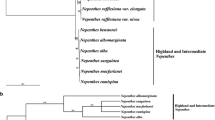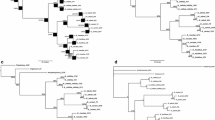Abstract
Parsimony-based phylogenetic analyses of the genus Guizotia were undertaken based on DNA sequence data from the following chloroplast DNA (cpDNA) regions: trnT-trnL, trnL-trnF, trnY-rpoB, trnC-petN, psbM-trnD and rps16-trnQ intergenic spacers, trnL, rps16 and matK-5′trnK introns and matK gene. Out of the 26 primers used in this study, 14 were newly designed. The study was conducted to determine (1) the closest relative of Guizotia abyssinica, (2) the taxonomic status of some Guizotia taxa and (3) the subtribal placement of Guizotia in the tribe Heliantheae. The analyses of the sequence data showed that G. abyssinica, G. scabra ssp. scabra, G. scabra ssp. schimperi and G. villosa are phylogenetically closely related. However, G. scabra ssp. schimperi appeared as the most closely related taxon to G. abyssinica. Based on this phylogenetic analysis, we suggest that the two subspecies of G. scabra are better treated as separate species. The analysis also clearly demonstrated that “Chelelu” and “Ketcha” are distinct Guizotia species. The trnT-trnL and trnL-trnF intergenic spacer-based phylogenetic analysis of various subtribes of the tribe Heliantheae strongly supports the placement of the genus Guizotia within the subtribe Milleriinae.



Similar content being viewed by others
References
Assefa K, Merker A, Hailu T (2003) Inter simple sequence repeat (ISSR) analysis of genetic diversity in tef [Eragrostis tef (Zucc.) Trotter]. Hereditas 139:174–183
Baagøe J (1974) The genus Guizotia (Compositae). A taxonomic revision. Bot Tidsskr 69:1–39
Baker WJ, Hedderson TA, Dransfield J (2000) Molecular phylogenetics of subfamily Calamoideae (Palmae) based on nrDNA ITS and cpDNA rps16 intron sequence data. Mol Phyl Evol 14:195–217
Bayer RJ, Greber DG, Bagnall NH (2002) Phylogeny of Australian Gnaphalieae (Asteraceae) based on chloroplast and nuclear sequences, the trnL Intron, trnL/trnF intergenic spacer, matK, and ETS. Syst Bot 27:801–814
Bekele E, Geleta M, Dagne K et al (2007) Molecular phylogeny of genus Guizotia (Asteraceae) using DNA sequences derived from ITS. Genet Resour Crop Evol 54:1419–1427
Bentham G (1873) Notes on the classification, history, and geographical distribution of Compositeae. J Linn Soc Bot 13:335–577
Bergqvist G, Bremer B, Bremer K (1992) Chloroplast DNA restriction site variation and phylogenetic interrelationships of some genera of the Heliantheae sensu lato (Asteraceae). Nord J Bot 12:149–154
Bofkin L, Goldman N (2007) Variation in evolutionary processes at different codon positions. Mol Biol Evol 24:513–521
Crawford DJ, Mort ME (2005) Phylogeny of eastern North American coreopsis (Asteraceae-Coreopsideae): insights from nuclear and plastid sequences and comments on character evolution. Am J Bot 92:330–336
Dagne K (1994) Meiosis in interspecific hybrids and genomic interrelationships in Guizotia Cass. (Compositae). Hereditas 121:119–129
Dagne K (1995) Karyotypes, C-banding and nucleolar numbers in Guizotia (Compositae). Pl Syst Evol 195:121–135
Dagne K (2001) Cytogenetics of new Guizotia Cass. (Compositae), interspecific hybrids pertaining to genomic and phylogenetic affinities. Pl Syst Evol 230:1–11
Downie SR, Katz-Downie DS, Sun F-J, Lee C-S (2008) Phylogeny and biogeography of Apiaceae tribe Oenantheae inferred from nuclear rDNA ITS and cpDNA psbI-5′trnK(UUU) sequences, with emphasis on the North American Endemics clade. Can J Bot 86:1039–1064
Geleta M, Bryngelsson T, Bekele E et al (2007) Comparative analysis of genetic relationship and diagnostic markers of several taxa of Guizotia Cass. (Asteraceae) as revealed by AFLPs and RAPDs. Pl Syst Evol 265:221–239
Hall T (2005) BioEdit v. 7.0.5. Biological sequence alignment editor for Windows. Ibis Therapeutics a division of Isis pharmaceuticals. http://www.mbio.ncsu.edu/BioEdit/bioedit.html. Accessed 06 Dec 2008
Hilu KW, Liang H (1997) The matK Gene: sequence variation and application in plant systematics. Am J Bot 84:830–839
Hiremath SC, Murthy HN (1988) Domestication of niger (Guizotia abyssinica). Euphytica 37:225–228
Hiremath SC, Murthy HN (1992) Cytological studies in Guizotia (Asteraceae). Caryologia 45:69–82
Hiremath SC, Murthy HN, Salimath SS (1992) Quantitative nuclear DNA differences associated with genome evolution in Guizotia (Compositae). Genetica 85:241–247
Humbles JE (1972) Observations of genus Sigesbeckia L. Ciencia Y Naturaleza 13:2–19
Johnson LA, Soltis E (1994) matK DNA sequences and phylogenetic reconstruction in Saxifragaceae s.str. Syst Bot 19:143–156
Karis PO (1993) Heliantheae sensu lato (Asteraceae) Clades and classification. Plant Syst Evol 188:139–195
Lee J, Hymowitz T (2001) A molecular phylogenetic study of the subtribe Glycininae (Leguminosae) derived from the chloroplast DNA Rps16 intron sequences. Am J Bot 88:2064–2073
Lee C, Wen J (2004) Phylogeny of Panax using chloroplast trnC–trnD intergenic region and the utility of trnC–trnD in interspecific studies of plants. Mol Phyl Evol 31:894–903
Liang H, Hilu KW (1996) Application of the matK gene sequences to grass systematics. Can J Bot 74:125–134
Mort ME, Archibald JK, Randle CP et al (2007) Inferring phylogeny at low taxonomic levels: Utility of rapidly evolving cpDNA and nuclear ITS Loci. Am J Bot 94:173–183
Murthy HN, Hiremath SC, Salimath SS (1993) Origin, evolution and genome differentiation in Guizotia abyssinica and its wild species. Theor Appl Genet 87:587–592
Oxelman B, Liden M, Berglund D (1997) Chloroplast rps 16 intron phylogeny of the tribe Sileneae (Caryophyllaceae). Plant Syst Evol 206:393–410
Padgett DJ, Les DH, Crow GE (1999) Phylogenetic Relationships in Nuphar (Nymphaeaceae): evidence from morphology, chloroplast DNA, and nuclear ribosomal DNA. Am J Bot 86:1316–1324
Pan J, Zhang D, Sang T (2007) Molecular phylogenetic evidence for the origin of a diploid hybrid of Paeonia (Paeoniaceae). Am J Bot 94:400–408
Panero JL, Jansen RK, Jennifer A et al (1999) Phylogenetic relationships of subtribe Ecliptinae (Asteraceae: Heliantheae) based on chloroplast DNA restriction site data. Am J Bot 86:413–427
Robinson H (1981) A revision of the tribal and subtribal limits of the Heliantheae (Asteraceae). Smithsonian Contrib Bot 51:1–102
Rozen S, Skaletsky HJ (2000) Primer3 on the WWW for general users and for biologist programmers. In: Krawetz S, Misener S (eds) Bioinformatics methods and protocols: methods in molecular biology. Humana Press, Totowa, pp 365–386
Sankoff D, Cedergren RJ, Lapalme G (1976) Frequency of insertion-deletion, transversion, and transition in the evolution of 5S ribosomal RNA. J Mol Evol 7:133–149
Schulz DL (1990) Zur kenntnis der Gattung Sigesbeckia L. in Africa. Gleditschia 18:211–218
Shaw J, Small RL (2005) Chloroplast DNA phylogeny and phylogeography of the north Americans plums (Prunus subgenus Prunus section prunocerasus, Rosaceae). Am J Bot 92:2011–2030
Shaw J, Lickey EB, Beck JT et al (2005) The tortoise and the hare II: relative utility of 21 noncoding chloroplast DNA sequences for phylogenetic analysis. Am J Bot 92:142–166
Simmons MP, Ochoterena H (2000) Gaps as characters in sequence-based phylogenetic analyses. Syst Biol 49:369–381
Small RL, Cronn RC, Wendel JF (2004) Use of nuclear genes for phylogeny construction in plants. Aust Syst Bot 17:145–170
Stuessy TF (1977) Heliantheae-systematic review. In: Heywood VH, Harborne JB, Turner BL (eds) The biology and chemistry of the Compositae, vol 1. Academic Press, London, pp 1106–1118
Swofford DL (2000) PAUP*: Phylogenetic analysis using parsimony, version 4.0, beta. Sinauer Associates Inc., Sunderland
Taberlet P, Gielly L, Pautou G, Bouvet J (1991) Universal primers for amplification of three non-coding regions of chloroplast DNA. Plant Mol Biol 17:1105–1109
Thompson JD, Gibson TJ, Plewniak F et al (1997) The CLUSTAL X windows interface: flexible strategies for multiple sequence alignment aided by quality analysis tools. Nucl Acids Res 25:4876–4882
Timme RE, Kuehl JV, Jeffrey L, Boore JL, Jansen RK (2007) A comparative analysis of the Lactuca and Helianthus (Asteraceae) plastid genomes: identification of divergent regions and categorization of shared repeats. Am J Bot 94:302–312
Wagstaff SJ, Breitwieser I (2004) Phylogeny and classification of Brachyglottis (Senecioneae, Asteraceae): an example of a rapid species radiation in New Zealand. Syst Bot 29:1003–1010
Acknowledgments
We thank Dr. Anders Carlsson and Dr. Peter Olsson for valuable discussions on the data analyses and Ms. Therése Bengtsson for her assistance with the laboratory work. We would also like to thank Professor Bengt Oxelman for his critical reading and highly valuable comments and suggestions on this manuscript. This work was financed by the Swedish International Development Agency (SIDA/SAREC) through the International Science Program (ISP).
Author information
Authors and Affiliations
Corresponding author
Rights and permissions
About this article
Cite this article
Geleta, M., Bekele, E., Dagne, K. et al. Phylogenetics and taxonomic delimitation of the genus Guizotia (Asteraceae) based on sequences derived from various chloroplast DNA regions. Plant Syst Evol 289, 77–89 (2010). https://doi.org/10.1007/s00606-010-0334-x
Received:
Accepted:
Published:
Issue Date:
DOI: https://doi.org/10.1007/s00606-010-0334-x




